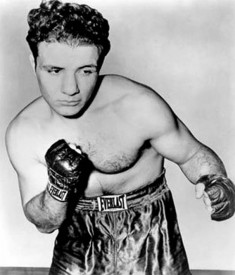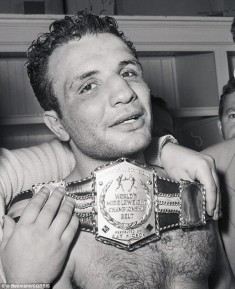| Jake LaMotta | |
|---|---|
 |
|
| Boxer | |
| Born | July 10, 1921 (age 92) The Bronx, New York City, New York |
| Nationality | American |
Jake LaMotta (born 1921) is a former American professional boxer. His true first name is Giacobbe, but he was universally known as Jake during most of his career.
LaMotta was world champion in the middleweight division, and he was also the inspiration for the Oscar-winning Robert De Niro film, Raging Bull. LaMotta was himself known as the Raging Bull and the Bronx Bull, too. He won more than 80 fights, but was best known for his matches against Sugar Ray Robinson.
Early Life
LaMotta was born in the Bronx, New York, on July 10, 1921. From an early age, he was known in his neighborhood for his bouts of ill temper. His father persuaded the boy to set up street fights in order to help earn money for his poverty-stricken family.
Before long, LaMotta turned his violent streak to crime, being sent to a reform school after being caught in the act of attempting a jewelry store robbery. By the time he was 19, though, he had turned his back on the underworld completely and had opted to try to make a name for himself as a professional boxer.
Creating a Boxer Mentality
From his early days in the ring, LaMotta displayed a relentless aggression and a sense of disdain for those who faced him. He would frequently employ mind games, pretending that he was in trouble in the hopes that his opponents would drop their guard a little.
When that happened, LaMotta would take the opportunity to strike. This was a dangerous tactic that sometimes ended with him taking hard punches – but he was already getting known for his “iron chin,” a reputation which would stay with LaMotta throughout his boxing career.
LaMotta in His Prime
At this time, the best boxer in the middleweight division by far was Sugar Ray Robinson, one of the most storied fighters of all time. There was little surprise when LaMotta lost his first match-up with the legendary champion, who was then unbeaten.
However, in 1943, LaMotta was granted a rematch and won, becoming the first man to defeat Robinson in his entire professional career. LaMotta then went on to fight a succession of hard-hitting fighters, including the likes of Tommy Bell, Fritzie Zivic, and Tony Janiro. He seemed unstoppable, which made his 1947 loss to Billy Fox one of the greatest shocks of the era. Although rumors persisted that the bout had been fixed, nothing was proven to that effect at the time.
Becoming a Champion
In 1949, LaMotta finally had the chance to fight for the middleweight championship of the world. His opponent was the Frenchman Marcel Cerdan, who put up a good performance but was no match for the American. Nevertheless, it was intended that the two men should fight again in the not too distant future.
The rematch never happened because Cerdan was involved in a fatal airplane accident. LaMotta instead fought a title defense against Tiberio Mitri before going on to retain his title in a bout with Laurent Dauthuille.
The End of a Career
 LaMotta succeeded in his goal to fight Sugar Ray Robinson once more when the pair met in 1951. The fight was considered one of the most brutal and exciting of all time, with LaMotta managing to withstand a seemingly unstoppable barrage of punches from Robinson.
LaMotta succeeded in his goal to fight Sugar Ray Robinson once more when the pair met in 1951. The fight was considered one of the most brutal and exciting of all time, with LaMotta managing to withstand a seemingly unstoppable barrage of punches from Robinson.
For 12 rounds the two men continued to fight. But in the 13th round, the referee had seen enough. Considering that the beating LaMotta was receiving had become too much, he ordered the bout to stop. It was the effective end of LaMotta’s boxing career. Although he did have a few more fights during the 1950s, he never again came close to having another title shot.
Life after Boxing
Once he had left the ring for good, LaMotta drifted in and out of a number of different jobs. He was first the proprietor of a Miami nightclub where he mingled with glamorous women like Hedi Lamarr and Jayne Mansfield, reputedly becoming close to both women.
In the late 1950s, however, he was sentenced to work on a chain gang after being convicted of corrupting a minor’s morals. He spent six months as a convict before he emerged to try his hand at stand-up comedy. He was only moderately successful at this, and another dark moment in his life arrived in 1960 when he admitted that he had deliberately lost his fight to Fox.
Later Years and Legacy
LaMotta wrote an autobiography in 1970 which director Martin Scorsese adapted as the film Raging Bull. The story did not spare the darker side of LaMotta’s life, including his domestic abuse of his second wife, Vicki. The movie’s critical and financial success brought the real LaMotta renewed interest from the American public, and in 1986 he brought out a second volume of his autobiography.
Two years later, two of his sons died in separate incidents within the space of a few months. In later life, LaMotta turned to making personal appearances and lending his name to a range of pasta products. He is currently married to his seventh wife and he was inducted into the International Boxing Hall of Fame.